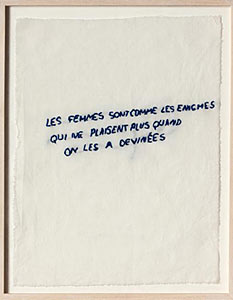
Born in 1943 in Berck-sur-Mer(FR)
Lives and works in Malakoff (FR)

1974
Embroided cloths
30 éléments, 35 x 28 cm chaque
Year of Purchase: 2000
Ma collection de proverbes (My collection of proverbs) is an anthology of received wisdom about women, hand-embroidered by the artist on pieces of white cotton; things like ‘When a girl is born, even the walls weep’, or ‘it was woman who turned the devil’s hair white’. With this proliferous work, Annette Messager mischievously gets mixed up in the geometrism and the quest for purity of Minimalism, literally pinning these ‘white squares’ that dominated the aesthetics of the time. She also mischievously loads them with the stupidity of the world, spreading out before us the worst the collective unconscious can come up with by way of male chauvinism. Throughout her career, Annette Messager has been tackling one cliché after another; without denouncing them, she takes their original form and subsequent variations as far as they will go. Making no value judgement, she forces viewers to face up to their own contradictions. This accounts for how the piece was greeted with great perplexity when it was first created in 1974. Raising the question of womanhood without becoming committed to women’s lib, she highlights a despised popular art, embroidery, in a seemingly provocative way. ‘A gesture that is at once vengeful and masochistic’, writes Catherine Grenier. By making her own the parody of this handicraft technique, Annette Messager hijacks the sign of submission to second-class status and promotes it to a form of beauty. She also asks herself where the boundaries of art lie, and questions them, notably by using poor materials like plush or pieces of cloth, mundane textures that have pervaded her work right up to the present.
This series is one of the numerous Collections the artist brought together in the early 1970s, a time when she divided her output up into cycles, each featuring a character she would invent for herself in schizophrenic succession; these belong to the ‘Annette Messager the collector’ cycle developed alongside the ‘artist’ cycle. The Proverbes thus join a set of 56 albums including lonely hearts adverts, press cuttings (Les Hommes que j’aime/j’aime pas [Men I like/don’t like]), photos (Les enfants aux yeux rayés [Children with their eyes scratched out]), magazine pictures, signatures or Rorschach inkblot tests. An embroidered litany, it also announces the coming cycle, that of the ‘handy woman’, in which Annette Messager focuses on ordinary manual tasks (Mes travaux d’aiguille, Quand je fais des travaux comme les hommes [My needlework, When I do jobs like men]).
Presented together, these small pictures invade the wall and seem capable of endless proliferation. Produced the same year as her first exhibition at l’Arc, where the artist showed dead birds, the Pensionnaires (Boarders) that made a name for her, they are a part of her revolution of the traditional hanging that impels her among other things to present her Collections in long display cases on legs, like the ones you find in an ethnology museum. ‘You can show things better by moving them and ordering them like in a cabinet of curiosities’, she says.1 Taking over and diverting the vocabulary of classification, the multiple, hysteric image imposes itself on the museum. Needlework as artwork.
Emmanuelle Lequeux
1 In conversation with the author, May 2005, unpublished.